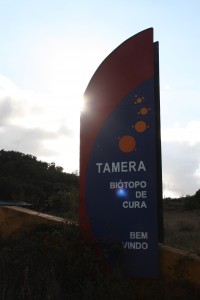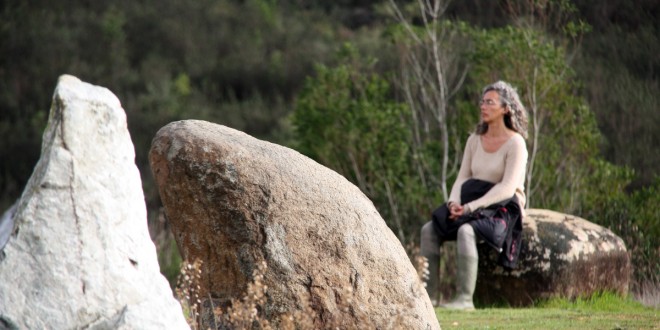
In the heart of the Lower Alentejo, an ecological village, practically self-sufficient, plans to show the way and offer local solutions for global problems, in harmony with the environment. A community which wants to do more and better, at a time when resources are increasingly hard to come by.
The bell rings. Once, twice, three times. It’s the signal that lunch is ready. It’s time to rest one’s body and placate one’s stomach. Gradually, the people who have been involved in different tasks throughout the community start to arrive for lunch. Their faces, flushed from working in the scorching heat, find a degree of respite in the shade around the kitchen of the Solar Village (Aldeia Solar). Lunch, all vegetarian, was cooked using solar power, using foodstuffs produced by the community or, if necessary, bought from local organic producers. In perfect harmony with the environment, the food takes on a different flavour, the aromas are fuller; this is one of the most ambitious projects in Tamera, making the most of one of the most abundant resources in the Alentejo: the sun.
In the Solar Village, the sun is the main raw material, the source of power behind this experimental project whose aim is nothing less than recreating a small village with all its energy coming from the sun. In this village, it is possible to cook on stoves adapted to use sunlight, which reaches them via reflective panels, to steam food or simply heat it in pans. By using heat to compress and expand the air, water can be pumped up from a depth of 50 metres. As Leila Dregger, one of the people responsible for the village, says, it is a system that could be used in Africa to combat desertification.
Tamera is like an oasis in the heart of the Lower Alentejo. Visitors can give their imaginations free rein, quickly forgetting that they are in southern Portugal, so lush is the landscape and so numerous the stretches of water in the 134-hectare property, which is shaped like an eagle. Despite its natural appearance, Tamera has its own, well-defined organisation. Water dominates the landscape, but the site comprises spaces such as the Solar Village, the Village of Light, the Stone Circle, the guesthouse, the auditorium and different areas for meditation and sharing of experiences, which blend together almost organically.
Tamera was founded in 1995 in the municipality of Odemira by three Germans: the theologian Sabine Lichtenfels, the sociologist Dieter Duhm and the physicist Charly Rainer Ehrenpreis. The initial idea was to start a community which would function as a research centre for social and ecological sustainability. Over the years, Tamera achieved this goal, and much more: a true home for people from a wide range of nationalities and backgrounds, in search of peace, for themselves and for others. The average number of people living in the community is 160; people come and go all the time, and there are 35 permanent residents. If people who live at Tamera are away, this can usually be explained by the commitment that members made when they joined the community, which means that they go out to work, as Leila Dregger says. “The members of the community made a commitment to contribute something every four months, when the funds are analysed, if there is a need”. Tamera manages to create new facilities thanks to “donations, and fund-raising from foundations and patrons who support it”, people who are interested in the type of research work they do. For day-to-day living, the community supports itself from the money raised from seminars and visitors.
It is a bit like a laboratory for what should be the ideal community, devoted to solving global problems, says Leila Dregger. “Tamera’s objective is to create a model for peace, with local solutions for global problems, so that people from all over the world can come and find ways of living in peace with nature and with each other”.
Tamera is in Monte do Cerro, between Relíquias and São Luís in the municipality of Odemira. And here on this property, at the top of the highest hill, silence reigns. The stones on the hilltop, the Stone Circle, give the place a mystical air. The site is inspired by the Almendres cromlech near Évora, and it both reflects the spiritual state of the community and has the community’s spiritual state projected into it. Each stone was placed there by a different person and symbolises an important aspect of the way Tamera is run, carved into the rock itself. This is the focal point where the energy is drawn together and driven into the soul of the project and the community. All around, the verdant vegetation dominates the view, the whole setting cradled in a watery landscape. And it is water, the primordial element which generates life and is the source of life, which breathes yet more life into Tamera. From time to time, visitors forget that they are in the heart of the Lower Alentejo, a region of dry, scorching land.
Water and light, always connected
When you get to Tamera along the dirt road, dry in summer and muddy in winter, a huge lake appears, gigantic in scale. It is this lake that divides and is linked to many others, providing the energy needed for nature to be revitalised and flourish in Tamera, season after season. The existence of the large lake allows “the landscape to be revitalised and its fertility to be restored”, according to Leila Dregger. A natural system of water management does more than just hold the water, it allows it to seep gradually into the ground, making it more fertile and providing a balance between fauna and flora. The lake made it possible for a landscape of aquatic permaculture to be created, established in Tamera under the guidance of its creator Sepp Holzer, an Austrian mountain farmer. The lush banks, the vegetable plots and gardens around the lake, green and luxuriant, are the living proof of the results, in contrast with the desert landscape which is all too evident around Monte Cerro.
Right next to the Solar Village, where lunch has now finished, can be found another part of Tamera, the Village of Light, a tribute to the land that was submerged when the Alqueva dam filled up. Two villages with the same name, one living, the other dead. One which died because of the water and the other whose water gave it life.
In this place of and made by women, the houses are divided up according to different activities, but they all have one feature in common: the older women teach the younger ones age-old skills. Like handicrafts, the painting, moulding and firing of clay, and about where the work is done; and the drying and use of herbs. These are skills that are handed down through time. And sewing is no exception.
With silvery hair and a wrinkled face, Alice Lindstedt has a cheery air. Originally from Germany, she has been at Tamera since 2001 and she’s in charge of the sewing area where clothing is put to good use, altered and shared. Where no one pays anything to use any of the items of clothing. Where people use things as they wish and where, if you no longer want or need an item, it can be returned for someone else to use, altered if necessary. A spirit of sharing and giving is what runs through Alice Lindstedt’s whole being; she’s a great-grandmother whose youngest descendent was born in Tamera, where her daughter and granddaughter also live. In a place where light and water are transformed into life and a little community serves as an example in the present day.
 Eco123 Revista da Economia e Ecologia
Eco123 Revista da Economia e Ecologia


